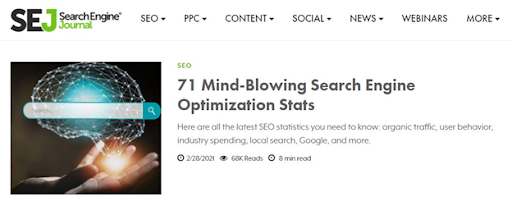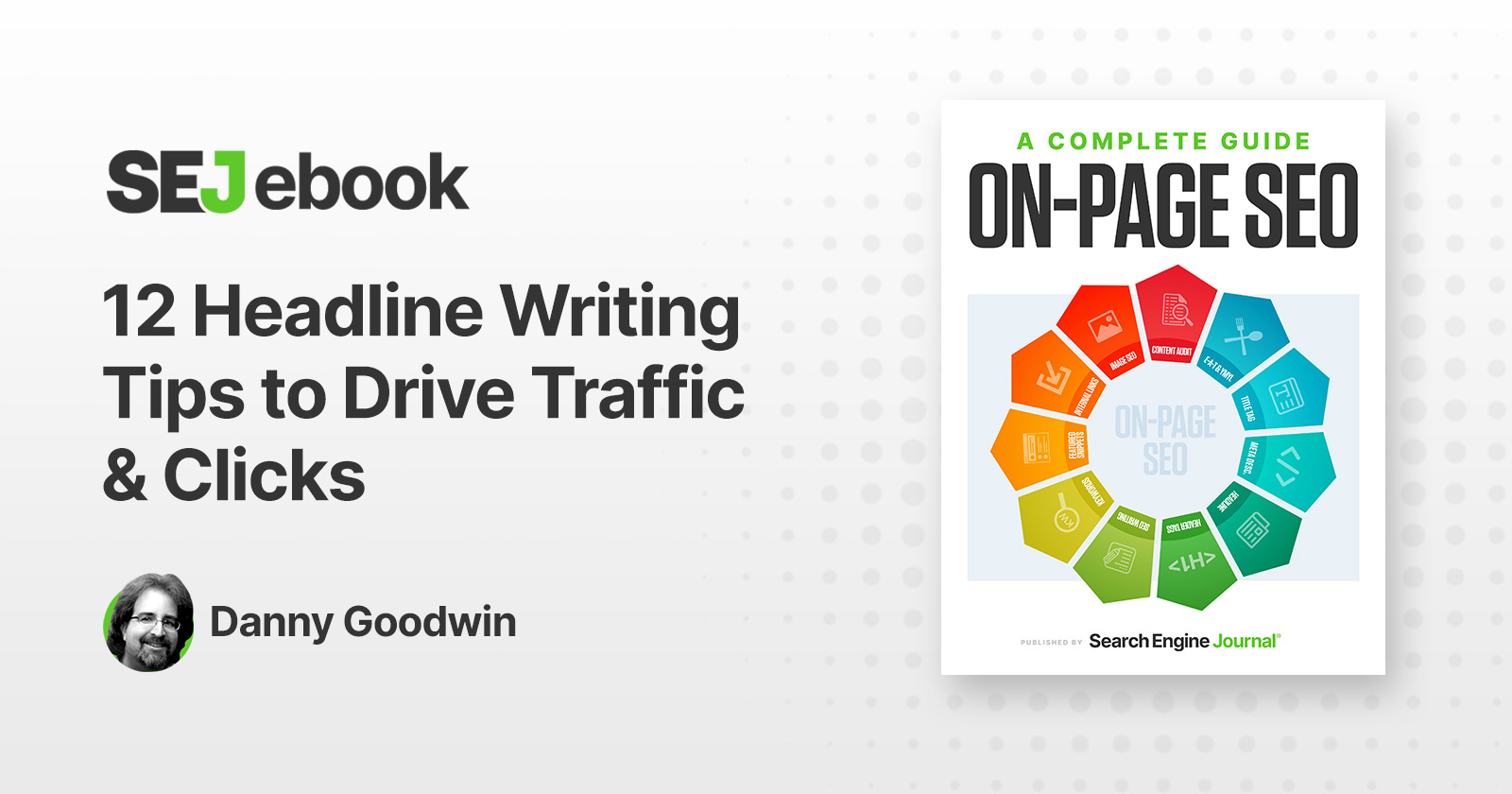Picture this: You’ve spent hours researching and writing a phenomenal article.
Obviously, you want people to read the article since you worked so hard to create it.
But here’s the sad truth: on average, 6 out of 10 people only look at the headlines before sharing an article. And only 49% claimed to read the articles.
What is a content creator to do?
There’s a clear connection between the value and interest of an article’s headline and whether people are intrigued enough to click on it.
Writing a strong headline isn’t an exact science, but plenty of data has been compiled and studied over the years to provide some clues as to what makes a strong headline great.
Here are some headline-writing tips to win those readers over and earn more clicks.
12 Tips To Write Click-Worthy Headlines
Your headline serves the essential role of making a first impression on a potential reader.
We all know how important first impressions are.
Being average isn’t better than being bad. Your headline is either exceptional, or it’s forgettable. There isn’t much gray area.
The following tips and methods below will help you turn a poor or average headline into one that earns clicks and pulls in readers.
1. Look At Google Search Results
Once you’ve researched the keyword(s) you’re planning to target, analyze the search engine results page (SERP) to see the articles you’re competing against.
How can your content stand out?
What is the user intent?
Are the top results listicles? How-to articles? Commercial content?
If you’re going to rank on Page 1, you need to have a comprehensive understanding of what kind of content is already there if you’re going to be a serious competitor.
2. Make An Emotional Connection
Emotional headlines dependably perform better than neutral ones.
Using power words to evoke emotions in your reader enhances their first impression of your content while building curiosity, dread, or anticipation to read more.
The best emotional headlines target:
- Happiness.
- Love.
- Fear.
- Anger.
- Disgust.
- Affirmation.
- Hope.
However, exercise caution when using emotional headlines. You don’t want to fall into the clickbait trap of not delivering what you promised readers.
3. Use Names
For this headline trick to be successful, the names need to be well-known to your target audience.
Brand names can be just as powerful as people.
For example, when targeting SEO topics, using “Google” in your headline will bring in clicks, as will using “John Mueller.”
These are widely recognized brands and figures within the industry.
The names you choose to feature in your headline should be tailored to your specific brand niche.
4. Use Numbers
Numbers are natural eye-catchers.
In an endless sea of words, numbers snag our attention and make us pause. We remember numbers because they help our brain organize information.
Use the power of listicles and numbers to beat your SERP competitors.
 Screenshot taken by author on July, 2021
Screenshot taken by author on July, 20215. Make The Benefits To Your Reader Clear
When a reader is deciding whether or not to click on an article, the question they’re asking themselves is, “What do I get out of this?”
Your headline should indicate the value a reader can expect from clicking through and reading it.
High-performing content serves one or more of these purposes:
- Entertain.
- Engage.
- Empower.
- Enrich.
- Educate.
- Inform.
- Inspire.
- Answer a question.
- Provide a solution.
When a reader decides to click on your article and invest their time and attention, they’ve already set expectations based on the benefit your headline promised.
Make your reader benefit clear, but don’t overpromise.
 Screenshot taken by author on July, 2021
Screenshot taken by author on July, 20216. Optimize For Humans And Search
Your first priority is optimizing so your human audience will find your content and want to click on it.
Your second priority is optimizing for search engines, especially Google.
The good news is, humans and search engines can generally agree on what they like to read, including content that is:
- Accurate.
- Comprehensive.
- Credible.
- Engaging.
- High-Quality.
- Informative.
- Specific.
- Unique.
- Useful.
- Valuable.
Be sure to include your primary keyword in the title to optimize it for Google and help people find your content when searching for the topic.
If you’re in need of inspiration, check out free title generator tools to help you write a better headline.
Keep in mind, though, that these tools don’t know your audience as well as you do, and just because a headline was generated automatically doesn’t mean it’s the most advanced for SEO.
These free tools are best used for idea generation and analysis, not a replacement for a human-created headline.
If you’re using WordPress, tools such as AIOSEO and Yoast are great SEO-based plugins that will give you a built-in analysis of your headline SEO rating (as well as the post as a whole).
They’ll also give you suggestions to help you improve your rating, as you can see with AIOSEO below:
 Screenshot taken by author on July, 2021
Screenshot taken by author on July, 20217. Write Multiple Headlines
Chances are, the first headline you come up with isn’t going to be gold.
And that’s okay! In fact, it’s normal.
Some people advise writing 10 or more headlines per content piece and then selecting the best option.
Write a variety of headlines targeting different formulas. Don’t just swap the word order.
Try targeting different emotions, points of view, and styles, such as:
- Humorous.
- Upbeat.
- Unexpected.
- Witty wordplay.
- Numerical.
- Question.
- Thought-provoking.
- First-person (I).
- Second-person (you/yours).
- Third-person (he/she/they/them).
Use headline analysis tools to keep track of SEO ratings for each option when you’re making your decision.
8. Test Your Headlines
Click data doesn’t lie, but your brain does!
Don’t be too mad at your brain – we’re all biased. Our brains convince us that we’re clever and creative, and of course, all of our headlines are genius.
But plenty of imaginative headlines never get a single click.
Despite what your brain thinks, the people bypassing your article aren’t to blame. It’s the headline.
Eliminate the bias by relying on quantitative data instead of your opinions and feelings.
9. Experiment With Headlines, Too
There’s an art to writing click-worthy headlines, and it does take some practice to make the task feel natural.
If you’ve followed every rule and still aren’t finding success, don’t be afraid to throw the rulebook out the window and go with your gut.
What kinds of headlines interest you? Go from there.
10. Follow Formulas
Even though there’s an art to crafting headlines, it’s important to keep in mind that your headline isn’t a whimsical creative writing assignment – it’s a science.
No, really.
Headline-writing formulas exist because they work. They’ve been tested over and over again to measure click-through rates.
Understandingly, this begs the question, “If everyone is using the same formulas, how can I make my headlines stand out from the crowd?”
The best advice is to create your own formulas by tweaking others and then testing your click-through rate (CTR) to find the ones that work best for you and your brand.
11. Should You Be Careful with Question Headlines?
Yes.
Question headlines can be an effective tool to spark reader curiosity, but they come with a warning label:
- Don’t ask a question that has an obvious answer. Nobody is going to read your content.
- Make sure you actually answer the question in the article. Don’t cop out and waste the reader’s time!
- Your answer should be better than other existing content that poses the same question.
- Be cautious about withholding information. Your content will come across as clickbait if you do.
- If the answer to your question is yes or no, don’t ask the question in the headline.
In most cases, you can write a more compelling headline that isn’t formatted into a question.
12. Be Positive
There’s enough negativity in the world without adding more gasoline to the fire.
Your primary goal should be to help your target audience, whether you’re providing useful information, solving a problem, answering a question, or entertaining your readers.
With that said, some brands want to be associated with negativity. Sparking controversy and getting people riled up does create a strong emotional response, albeit not a positive one.
It all depends on your brand image and the message you want to convey to your audience.
Write Compelling Headlines That Win Readers
If you’re going to break that 6 out of ten reading statistic, your headlines need to raise the stakes.
That’s going to require a lot of trial and error.
Even if you follow every piece of advice in this article, that isn’t a surefire formula for success every single time.
Pay attention to your audience within your specific niche. What are they clicking on? Which headlines are piquing their interest? Which ones aren’t?
Just like every other type of content marketing strategy, follow-up data and analysis are critical to understanding how to best target your specific audience.
Image Credits
Featured Image: Paulo Bobita/Search Engine Journal
All screenshots taken by author





![AI Overviews: We Reverse-Engineered Them So You Don't Have To [+ What You Need To Do Next]](https://www.searchenginejournal.com/wp-content/uploads/2025/04/sidebar1x-455.png)